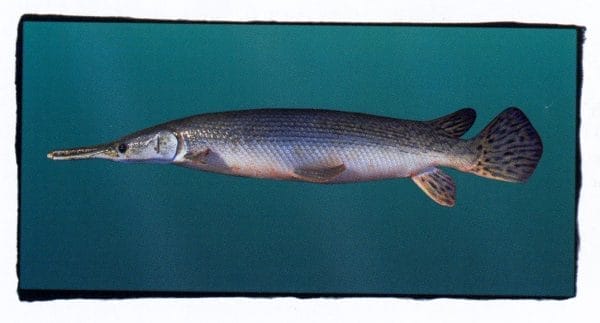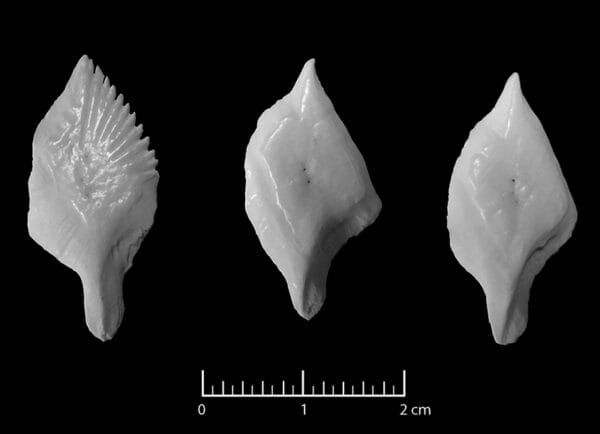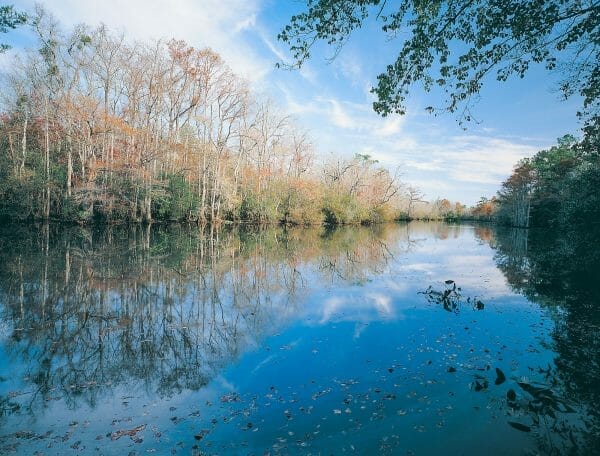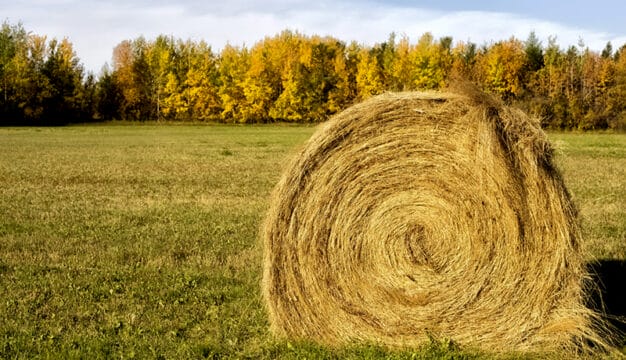Alligator Gar
 Alligator Gar
The alligator gar (Atractosteus spatula) is a primitive carnivorous fish found throughout the American South. In Alabama, it is mainly found in the river systems of Baldwin, Clarke, Escambia, Mobile, and Monroe Counties, all of which are part of the larger Mobile-Tensaw Delta system. While neither Alabama nor the federal government recognizes the species as endangered, the Alabama Natural Heritage Program lists the fish as imperiled, meaning A. spatula is at risk for extinction in the state. The alligator gar was first described by French naturalist Bernard Germain de Lacépède in the fifth volume of his five-volume Natural History of Fishes, published in 1803. Its common name refers to its resemblance to the American alligator.
Alligator Gar
The alligator gar (Atractosteus spatula) is a primitive carnivorous fish found throughout the American South. In Alabama, it is mainly found in the river systems of Baldwin, Clarke, Escambia, Mobile, and Monroe Counties, all of which are part of the larger Mobile-Tensaw Delta system. While neither Alabama nor the federal government recognizes the species as endangered, the Alabama Natural Heritage Program lists the fish as imperiled, meaning A. spatula is at risk for extinction in the state. The alligator gar was first described by French naturalist Bernard Germain de Lacépède in the fifth volume of his five-volume Natural History of Fishes, published in 1803. Its common name refers to its resemblance to the American alligator.
Alligator gars are long, narrow fishes commonly ranging in adult length from about 20 inches (~ 0.5 meters) to almost 7 feet (~ 2.1 meters), with females usually being larger than males. Rare specimens up to almost ten feet (~ 3 meters) and 300 pounds (~ 136 kilograms) have been recorded, easily making them the largest fish in the gar family, or Lepisosteidae. This family encompasses a group of primitive carnivorous fish with long snouts that typically inhabit murky fresh and brackish water. Gars are considered primitive because they have not evolved much from their current form in more than 60 million years, like other primitive species such as the crocodile. The alligator gar is very long-lived, with females living up to 50 years and males living up to 25 years. The oldest specimen recorded was a 95-year-old fish caught in 2011 in Mississippi.
 Alligator Gar Scales
Adult alligator gars have whitish bellies and tan or dark brown upper bodies, with speckled throats, rounded tails, and lobe-shaped fins. Like other gars, they have hard, bony, interlocking scales that form a protective armor. The scales are so hard that they were used by southeastern Native Americans as projectile points and other useful items. Alligator gars are distinguished from other gars by their two rows of upper teeth, with the second row being located on the roof of the mouth. Such teeth are called vomerine teeth. Gars are also capable of breathing air with a specially modified swim bladder, an important adaptation in its often oxygen-deprived environment.
Alligator Gar Scales
Adult alligator gars have whitish bellies and tan or dark brown upper bodies, with speckled throats, rounded tails, and lobe-shaped fins. Like other gars, they have hard, bony, interlocking scales that form a protective armor. The scales are so hard that they were used by southeastern Native Americans as projectile points and other useful items. Alligator gars are distinguished from other gars by their two rows of upper teeth, with the second row being located on the roof of the mouth. Such teeth are called vomerine teeth. Gars are also capable of breathing air with a specially modified swim bladder, an important adaptation in its often oxygen-deprived environment.
Spawning commonly occurs between April and June, when seasonal floods create murky waters in the gar’s vegetated habitats and provide safe spawning areas for adults and a nursery area for juveniles. Typically, females breed with between three and seven males, who follow her into shallow areas and fertilize her eggs. The eggs then attach to vegetation or the substrate via a sticky coating. Clutch sizes are highly variable but average around 157,000 eggs per female. The eggs are toxic, and their bright red coloring warns predators of this. Hatchlings attach themselves to vegetation with an adhesive structure called a suctorial disk for the first four days.
Both juvenile and mature gars are opportunistic carnivores, moving onto flooded plains to feed on a wide range of fish, amphibians, and insects, but they have been known to eat mammals and birds as well. Alligator gars hunt by surprise and camouflage: They bask near the water’s surface, imitating a log and waiting for approaching prey. Then they rapidly snap their heads to the side and impale their prey with their many teeth. After making a catch, gars will often carry their prey to the bank and eat it there, head first. The majority of alligator gars don’t begin feeding until water temperatures reach 70 degrees, and it is likely that these fish undergo a dormant period similar to hibernation during the colder months. When young, gars are preyed upon by a number of other carnivores, but once they become large, they are generally safe from all predators other than humans.
Once considered purely a river species, alligator gars thrive in a variety of aquatic habitats, including swamps, floodplains, bayous, and oxbow ponds. They prefer freshwater, but they also tolerate brackish and salty water in the southern parts of their range. Consequentially, these gars are often found in areas of great biodiversity, such as floodplains and marshes. The most common habitats for adults, however, are large flowing water sources with a moderate current and a bottom consisting of sand, silt, gravel, or mud.
The Alabama Department of Conservation and Natural Resources considers alligator gars commercial or non-game fish, meaning that they can be harvested and sold and thus have direct value to the economy. Their meat, described as tasting like catfish, is sold at markets throughout the southern United States. Their hide and scales have also been used for various purposes, including leather, bug repellent, and even jewelry. The fish are also popular with trophy fisherman because of their large size. The fish have also recently been raised domestically in other countries for many of these products, as their fast growth and large size makes them an economically viable species.
 Mobile-Tensaw Delta
Wild alligator gar populations are declining not just in Alabama but across most of their U.S. range. The greatest threats come from humans, with overfishing and habitat degradation leading the way. For almost 50 years, alligator gars suffered from a “kill on sight” policy by fishermen, based on a myth that these fish were so gluttonous that they would eat their own weight in game fish every 36 hours. No studies have ever backed up this claim, but public perception of the species led to significant declines in populations. Habitat degradation, an issue for almost all waterways in Alabama, is a factor as well. The 22 dams in the Mobile River system have altered flow patterns and cut off access to spawning pools on floodplains used by the species. Additionally, the construction of U.S. Route 90, a causeway built mostly of solid earth, blocked the connection between the Mobile River delta and Mobile Bay, decreasing open water habitats frequented by A. spatula.
Mobile-Tensaw Delta
Wild alligator gar populations are declining not just in Alabama but across most of their U.S. range. The greatest threats come from humans, with overfishing and habitat degradation leading the way. For almost 50 years, alligator gars suffered from a “kill on sight” policy by fishermen, based on a myth that these fish were so gluttonous that they would eat their own weight in game fish every 36 hours. No studies have ever backed up this claim, but public perception of the species led to significant declines in populations. Habitat degradation, an issue for almost all waterways in Alabama, is a factor as well. The 22 dams in the Mobile River system have altered flow patterns and cut off access to spawning pools on floodplains used by the species. Additionally, the construction of U.S. Route 90, a causeway built mostly of solid earth, blocked the connection between the Mobile River delta and Mobile Bay, decreasing open water habitats frequented by A. spatula.
Alligator gars will need proactive management to ensure their continued existence in the wild, including protection of floodplains, oxbow ponds, and other key habitat areas. Size limits for fishing will also be an important step for its conservation. Given the length of time to reproductive age, adults will require the greatest protections. Several methods of protection show promise, including maximum harvest sizes, catch quotas, refuges, and fishery closures. Additionally, a trophy system that allows limited harvest would enable scientists to collect important data that can be used to further refine the management plan for the alligator gar.
Further Reading
- Ferrara, Allyse M. “Life-History Strategy of Lepisosteidae: Implications for the Conservation and Management of Alligator Gar.” PhD dissertation. Auburn University, Auburn, Alabama. 2001.
- Irwin, Elise R., Ashley Belcher, and Kevin Kleiner. Population Assessment of Alligator Gar in Alabama. Final Report, Project F-40 (Study 36). Montgomery: Alabama Department of Conservation and Natural Resources, 2001.
- Smith-Vaniz, William F. Freshwater Fishes of Alabama. Auburn, Ala.: Agricultural Experiment Station, Auburn University, 1968.
- Wiley, Edward O. “The Phylogeny and Biogeography of Fossil Recent Gars (Actinopterygii: Lepisosteidae).” PhD dissertation. University of Kansas, Lawrence, Kansas, 1976.



